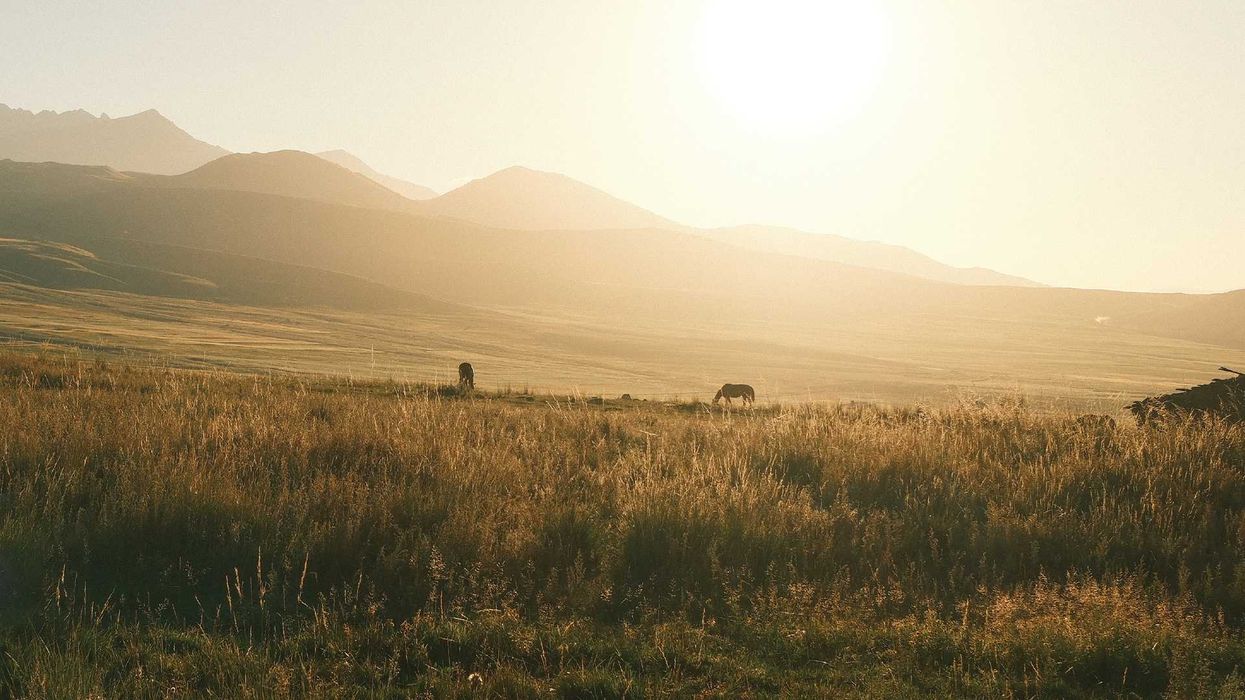
Dr. Benjamin Braddock

Where glaciers shine and night skies blaze, the old gods still whisper—one man's journey of initiation into the oldest ways of life.
The pitch was appealing, even if light on details: “We’re riding with nomads in Kyrgyzstan.” Sitting outside Le Bonne Vache, my favorite Georgetown cafe, I was in an unusually good mood. It is one of the few restaurants open today that has managed to cultivate an atmosphere of romance, to draw man out of his bleakness for a time. “Extremely tempted,” I texted back. I paused and took another bite of my boeuf bourguignon burger. “LFG.”
I had been wanting to go to Central Asia this year—in part because I have been working on a book about horse culture, in part because the more conventional destinations have been flooded by a tide of Americans feverishly running to and from the ends of the earth in search of Lord only knows what. The average weekday at an international airport in the United States resembles the fall of Kabul. I would not be surprised to see dozens of people falling from the outside of a 787 departing JFK for Paris. These people have turned Italy and France into theme parks, incited riots in Mexico, laid siege to Spain, and driven the fathers of Medellin to hide their daughters in attics and cellars. They are not dissuaded by war, pestilence, famine, or disease. Inflation only encourages them.
Fortunately, a few countries still lack the infrastructure and English skills to be overtaken by this swarm. Kyrgyzstan is one such country. The one international airport is functioning essentially because the United States repaired and expanded it when they needed to borrow it for the invasion of Afghanistan. The lingua franca is Russian, not English. Close ties are still maintained with Russia, notwithstanding recent moves towards de-Sovietization, such as relocating the largest statue of Lenin in Central Asia to a less prominent location in the second-largest city, Osh.
Streaking towards us like the pale horse of Revelation, he was trailed by fire and embers that set patches of grass along the road ablaze.
Being a “-stan” also helps Kyrgyzstan avoid too much particular attention. The trip was organized by IO, an intentional community dedicated to transformative group adventures, and Rogue, an American refugee from the repressive COVID-era mass psychosis that gripped our country.
The Kyrgyz love freedom as a matter of fact—not ideology. Kenai, the Kyrgyz nomad and champion stunt rider who was the main guide for our trip, proudly told me about how he delivered both of his children at home. They had never been to a doctor or received vaccines, and they did not even have birth certificates.
Family and friends kept asking why I was going to Kurdistan or Kazakhstan. My aunt called to warn me about the dangers of Afghanistan. The goal of the trip was simple: to survive a horseback expedition over the most treacherous mountain route in the country, take numerous pictures, and geta feel for the life of a free nomad roaming the mountains and open steppe.
The flight touched down in Bishkek at 3:30 a.m. local time. After clearing customs, we found our Yandex Go (the Russian equivalent of Uber) drivers and set off for the Golden Dragon, a Chinese casino and hotel.
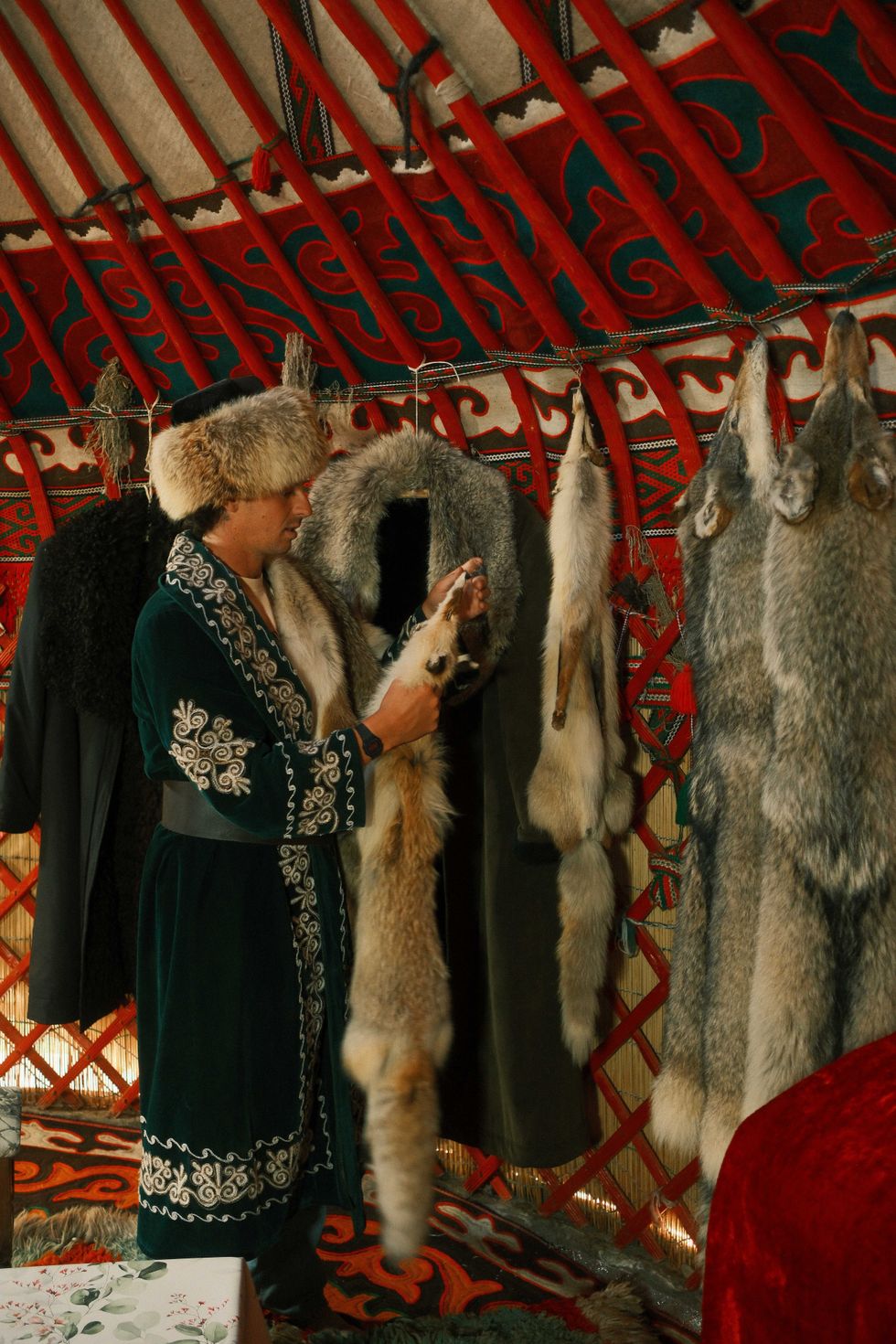
Check-in to our rooms was not available until the afternoon, but the receptionist let us pile our bags up by the desk and sprawl out in the lobby under the watchful busts of Lenin and Marx. A barman brought out plates of Chechil, a delicious, smoked, stringy cheese, along with something called kurut, which is fermented milk curds dried into hard, marble-sized balls. I popped one of the kurut balls into my mouth and swished it around with a swig of Arpa per the barman’s instruction. As it began to soften, a pleasantly salty yogurt-cheese flavor emerged. I was told that kurut is a favorite food of the nomads, going back to at least the time of Genghis Khan, whose troops carried it on their military campaigns.
Thus refreshed, our horde set out for Ala-Too Square to see the great statue of Manas, the heroic leader who united the 40 clans of Kyrgyzstan (Kyrgyz is derived from the old Turkic word kyrk, meaning “forty”) against the Khitans, a nomadic people inhabiting parts of modern-day Mongolia and northern China. From there, we set off for the Dordoy Bazaar, one of the largest public markets in Asia—a labyrinthine agglomeration of double-stacked shipping containers whose stalls employ approximately 70,000 people. It felt like the cantina in the original 1977 Star Wars had merged with Bartertown from Mad Max Beyond Thunderdome.
I endeavored to locate a Soviet-era suitcase nuke. Unsuccessful, I settled for a native riding costume and some headlamp batteries. The following day, our group piled into a Sprinter van and set off for the camp of an eagle hunter in the hills outside of Issyk-Kul, a vast, saline lake located on the western side of the Tengri Tagh (Turkic for “Mountains of Heaven”) mountain range.
We began acclimatizing at approximately 8,400 feet of elevation, preparing to ride into the high country, where the nomads graze their cattle, sheep, horses, and yaks in the summer. One of the yurts was set up with three long, low tables piled with fruit, fried puffed bread squares called boorsok dipped in a delicious homemade raspberry jam, and miscellaneous dates, raisins, nuts, and candy. Huge platters of meat and potatoes, accompanied by sliced raw onions, were carried in. We were told to eat everything. A couple of hours later, we were herded back into the cafeteria yurt to have a second dinner. The thought crossed my mind that perhaps we had fallen into the hands of a cannibal tribe who were intent on fattening us up, but then I learned that our nomad guides were just preparing us for the days ahead.
Our group of Westerners, mostly unfamiliar with each other, and the nomadic guides, who were unfamiliar with the rest of us, began to build camaraderie that night, much in the same way young boys do, through games familiar to us, like tug of war, and exotic local ones. In one amusing local game, a group links into line to form the body of a “horse.” One person jumps onto their backs like a rider. The “horse” then tries to buck and thrash around to get the rider off.
You move beyond exhaustion into a state that feels like floating. Your brain has run out of thoughts.
This was about when the nomads started giving us our Kyrgyz names. I was dubbed Amanbek.
On the second day at base camp, the horses arrived. The first riding session went relatively smoothly. We learned the Kyrgyz horse commands: a “Choo” sound is used to urge the horse forward, and a “Drrr”(with rolling r’s) sound is used to slow or stop the horse. Rolling the r’s correctly took some practice: the horse would not slow down if I didn’t roll them right. The second riding session—out in the hills with the eagle hunter—was borderline comedic. It was as if in the course of several hours the horses had become possessed by the spirits of mules. The horses stood around lazily as cries of Choo, Choo, Choooo went up from the group.
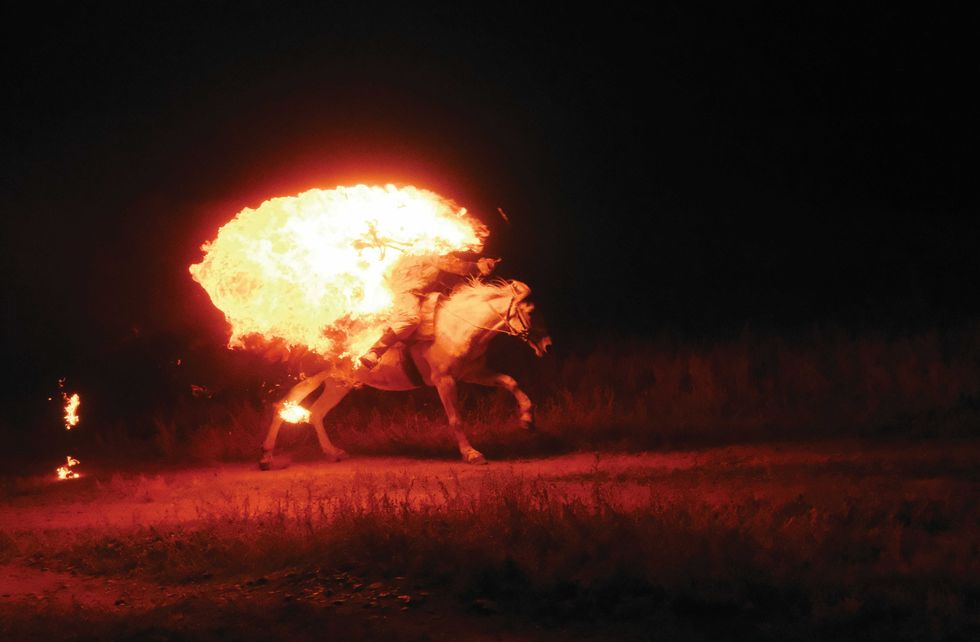
Prodding and spurring had no effect. Our nomad guides had initially reserved the use of whips for themselves, but fashioning some for us from branches, they passed them out only for them to muster a few half-hearted steps. I thought to myself, “If the horses are going to be like this for the entire trip, we’ll be lucky to make it out of sight of base camp.” This episode became all the more strange when it never happened again.
That night, we were treated to a show before dinner in which one of the nomads donned a heavy coat smeared with dung and was then doused in petrol before he mounted and was set on fire. Streaking towards us like the pale horse of Revelation, he was trailed by fire and embers that set patches of grass along the road ablaze.
Dinner that night was Plov, a concoction of rice, lamb, and carrots. Early the next morning, we set out for the high country. The horses had recovered from their stubborn laziness the evening before and jostled for position before finally settling into the hierarchy of the day. Some of the horses had a definite preference, remaining unchanged over time, for being at the head of the herd. Initially, my horse was content to fall in line, but he had a habit of tailgating, which resulted in a couple of strong kicks to the face, and for the rest of the trip he was chomping at the bit to be up in front. He was a slow walker and a fast runner. He had a gait beyond the gallop, a sixth gear that was like riding on the back of a winged pegasus in flight, with the long stride of a racehorse. I called him Music.
Our party followed a long road to its end at a river flowing out of the high mountains. Crossing the river and climbing into the steep valley, we left any semblance of civilization behind. The way opened up into broad, green pastures framed by glacier-clad mountains. The horses began to run of their own will. Small herds of cattle looked up lazily from their grazing. Our first lunch was a great relief. Not of hunger, but of wondering what meals on the trail would be like.
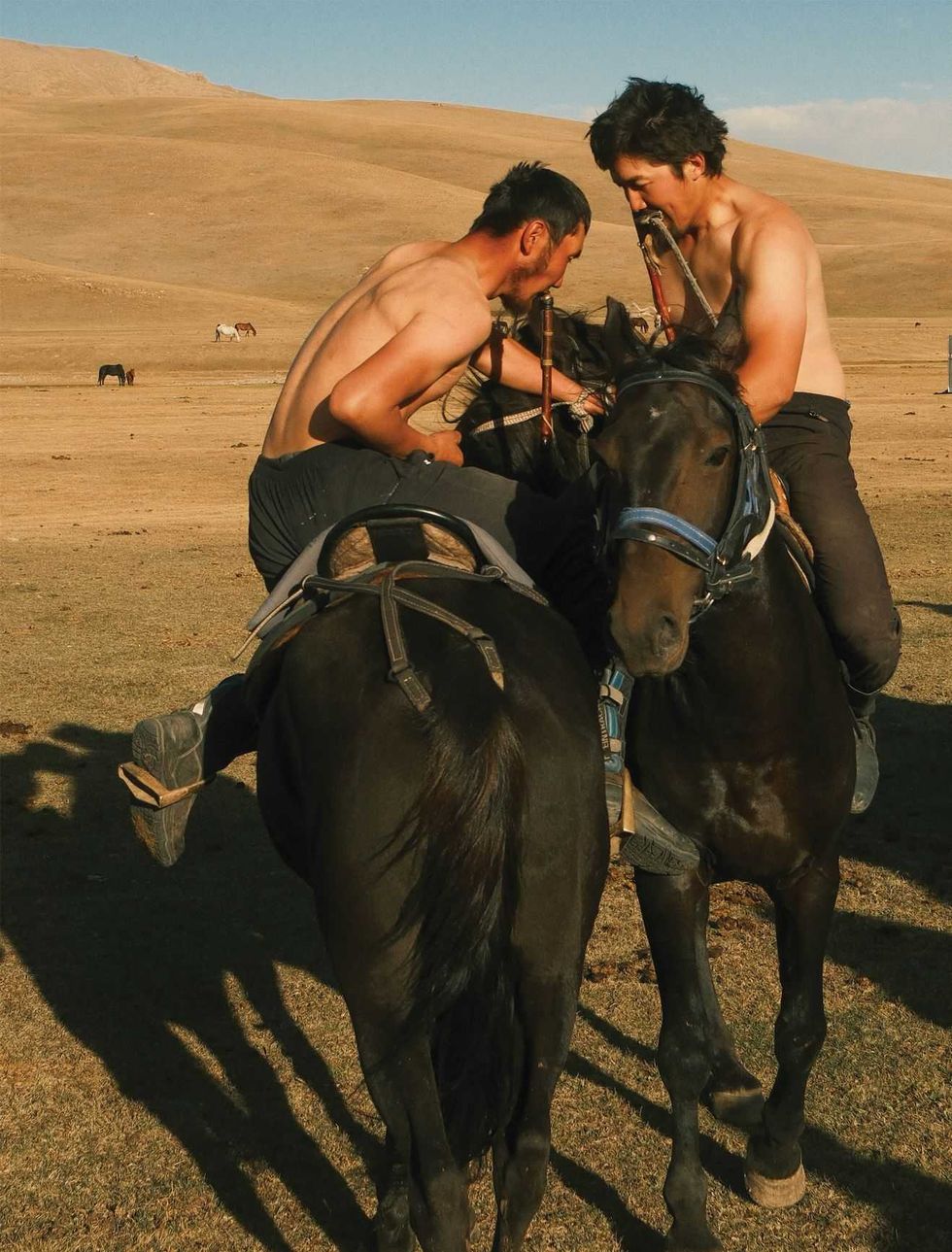
The nomads’ efforts to fatten us up back at base camp had raised some concern that we might be subsisting on canned horsemeat the entire time. Canned horsemeat did appear at breakfast a couple of times, but it turned out to be just one delicacy out of a sufficiently varied menu. After the bulk of the party had plunged into an ice-cold stream and were sprawled out on the grass drying under the sun, Kenai came along and cautioned that lying on the ground was a sure way to get chilled. Sometimes he was unintentionally funny like that.
Kenai thankfully did not have the bearing of a guide who had over-professionalized. He was rich in sage wisdom. On marriage, he advised taking a wife from a tribe with good grazing lands (Ala kachuu, a form of bridenapping, is still common in Kyrgyzstan); on selecting a wife, “a good heart, a little beauty, it’s enough.” For a nasty infection in my calf, he had me apply honey from his grandfather’s hives: “Our region has the best honey in the Soviet Union.” The honey worked in two days and the infection was greatly diminished.
Back in the saddle, we continued along the stream until the valley ran out and we traversed up to the edge of a basin ringed by mountains and glaciers. At the saddle of the basin, we found ourselves staring into another basin ringed by even bigger, more rugged, and foreboding mountains. There were no plants or grass of any kind to be seen, just an expanse of bare rock and gravel with two small alpine lakes, one a muddy-grey color and the other of the purest turquoise blue. Our lead guide urged his horse straight up the steep slope to our left. We sat waiting, thinking he was showing off or gaining a vantage point, until he called back, “C’mon.” The day before this, we could hardly get our horses to walk on flat ground—now they were scrambling up the face of a mountain as the gravel slid away under their hooves. Climbing upwards, we finally reached a narrow shepherd’s path that led us along the mountainside, past a bleached horse’s skeleton, past a lone cow that had somehow wandered over the13,400 foot pass, until we finally reached the far ridge of the basin.
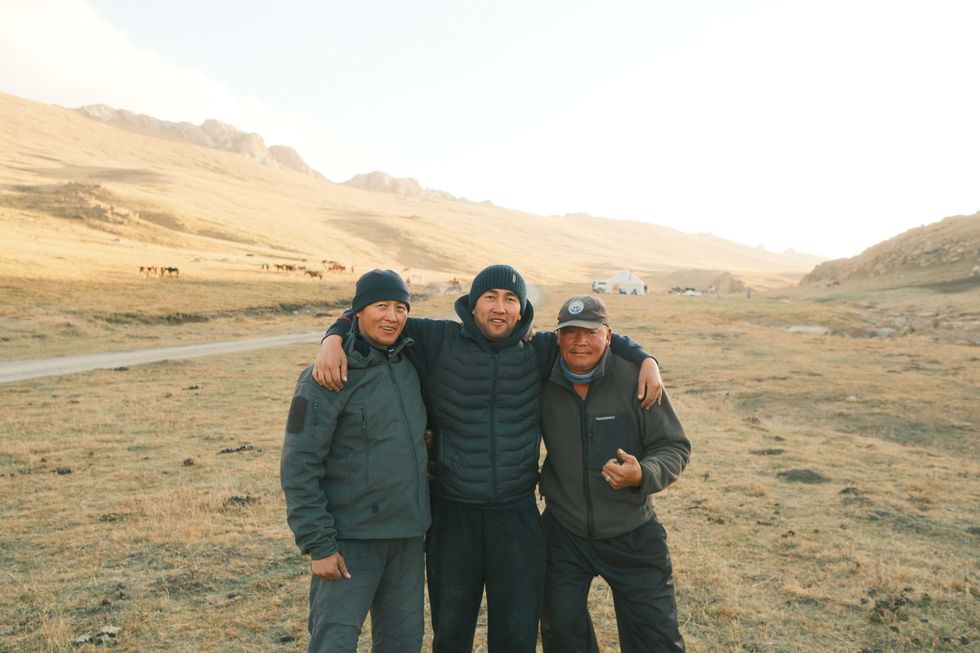
Descending into the next valley, I quickly came to learn that going downhill would be a lot more physically taxing than going uphill. The angle ensured that my crotch took the brunt of each step the horse took. My stirrups, even lengthened to the last notch, were much too short for my legs, which consequently were too bent to shift much of my weight into the feet. I ended up getting a tremendous triceps workout from bracing against the pommel in an effort to protect my family jewels.
It is one thing to go for a leisurely ride. It is another to go on a multi-day ride. Few pack outfitters would plan beyond 15 miles in a day. It is yet another thing altogether to ride with nomads who think nothing of throwing you into 30+ mile days stacked back to back. Your saddle sores develop saddle sores, muscles in your legs that you had never known existed begin to protest, and ligaments start to ache in strange ways. The romance of the open steppe gives way to the more pressing need of overcoming the protests of your body, hour after hour, mile after mile. But it is through the haze of exhaustion and fighting to override discomfort that you begin to understand something fundamental about yourself. The way reveals its secrets only to those willing to pay the physical toll to learn them. Then, at some point, the body moves past rebellion into acceptance. The horse no longer feels like a separate entity, but someone you have become psychically connected with and whose instincts you learn to trust.
You move beyond exhaustion into a state that feels like floating. Your brain has run out of thoughts—you have transcended the vulgar need to think and discovered instead a kind of pure existence in which you are no longer an observer of existence but an integrated part of it.
The health effects of the combination of high altitude, high UV, and wide temperature variability warrant mention. For most people, modern life near sea level means a high availability of oxygen and a lot of time indoors with a thermostat constantly set to a level where the body’s innate heating and cooling processes are never activated. When there is sun exposure, UV levels are about 50 percent more intense at high elevations. What feels like physiological stress in the first days at high altitude is really your body remembering how to be truly alive.
New oxygen-carrying red blood cells are spawned at a rapid rate, the heart becomes stronger and more efficient, mitochondria multiply and strengthen in response to the thermal stress, sleep cycles synchronize with natural light and temperature patterns, melanin is produced in deeper layers of the skin in response to the stronger UV, and the entire endocrine system rebalances. These forces of nature forge physiological excellence.
Despite this being the inaugural ride and the horses having never traversed this route before, they always knew when we were nearing camp. Their ears would prick up and their gait would quicken. Our tent village would spring up in just a few moments—everyone wanted to get their sleeping quarters squared away with no delay. Dinner was never far behind. A long plastic sheet was rolled out. Legs still exhausted from riding, I found the prone sniper position to be the superior seating style for eating. Some nights, we had meat and potatoes or rice; other nights, soup and lepyoshka, a traditional disk-shaped flatbread.
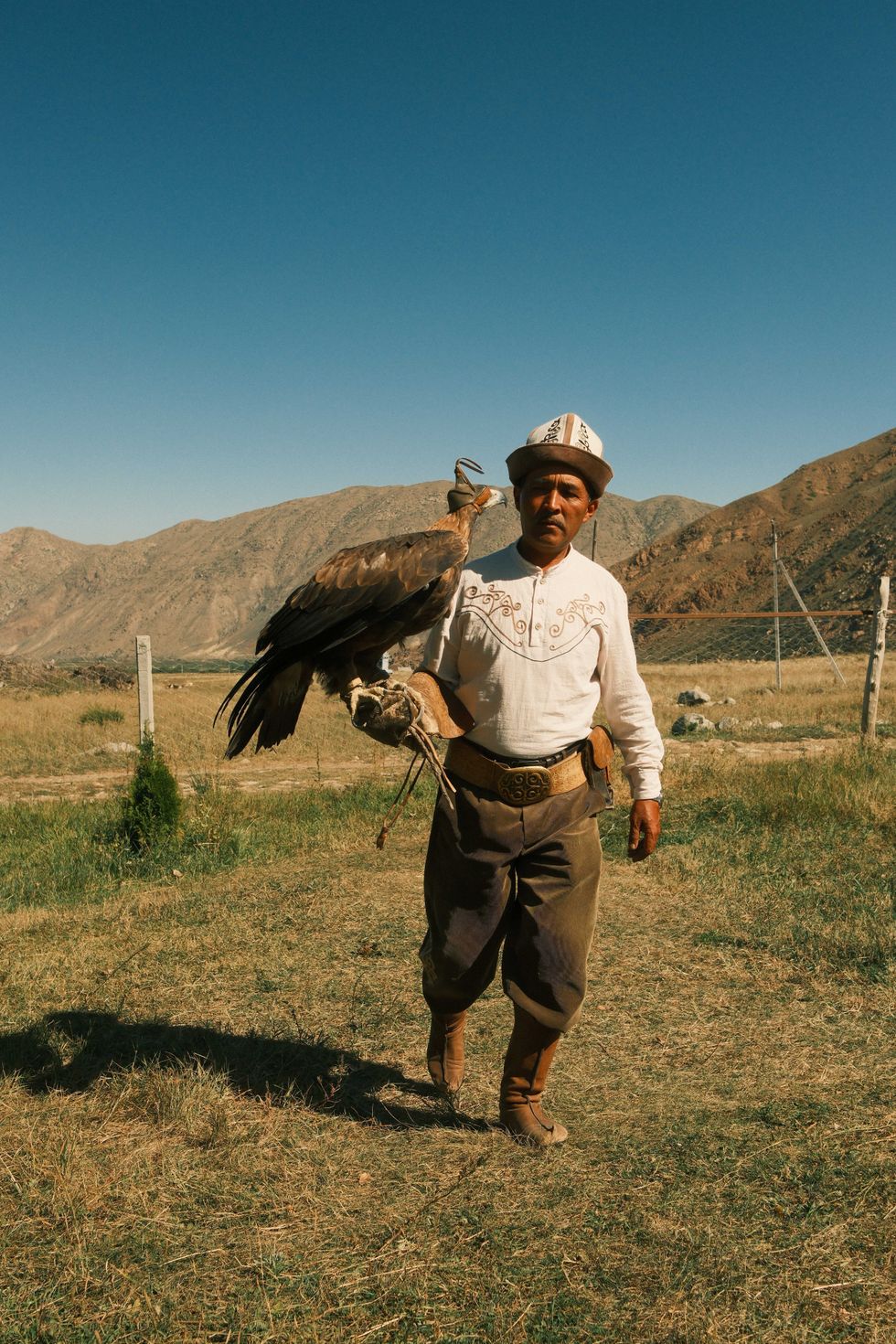
At such an altitude and distance from any settlement, the night sky was an incredible sight, but for the first couple of nights, I was in my sleeping bag before the last light of dusk had faded from the horizon. The most challenging day was both the longest in distance and the hardest in terrain, as it involved going up and over two steep mountains of high prominence, well above the permafrost line, where feces no longer decay.
The average weekday at an international airport in the United States resembles the Fall of Kabul. I would not be surprised to see dozens of people falling from the outside of a 787 departing JFK for Paris.
Our group reached the second mountaintop before noticing that several of our guides had fallen behind. We later found out that one of the pack horses had collapsed and was in danger of dying, and that had tied up the guides. The sun was sinking, and the temperature was falling with it. After losing about 20 minutes of daylight, we decided to press on. My horse did not want to go down the mountain and would only slowly and carefully pick his way down with urging. As the group went ahead and I began falling further behind, my concern about getting lost in the mountains at night overrode my trust in the horse, and I pushed him harder to pick up the pace.
The reason for my horse’s careful and slow descent became apparent when my saddle came off with me in it.
The girth had broken loose and there was no back cinch to serve as a backup—the horse had gotten me much of the way down a steep mountain with nothing holding the saddle on, which was not obvious given the way my weight had shifted it forward against his shoulders. I felt like Balaam after discovering his ass had saved his life. Luckily for me, Music did not take his chance to exact revenge by leaving me to freeze on the mountainside, but stopped and waited for me to get resituated. We started again down the long valley, and he picked up the pace on his own. He understood we had to make time. The missing guides appeared, and so did the eastern compulsion to save face: I got an earful on the inadequacies of my girth fix and the order to “Gallop bro.”
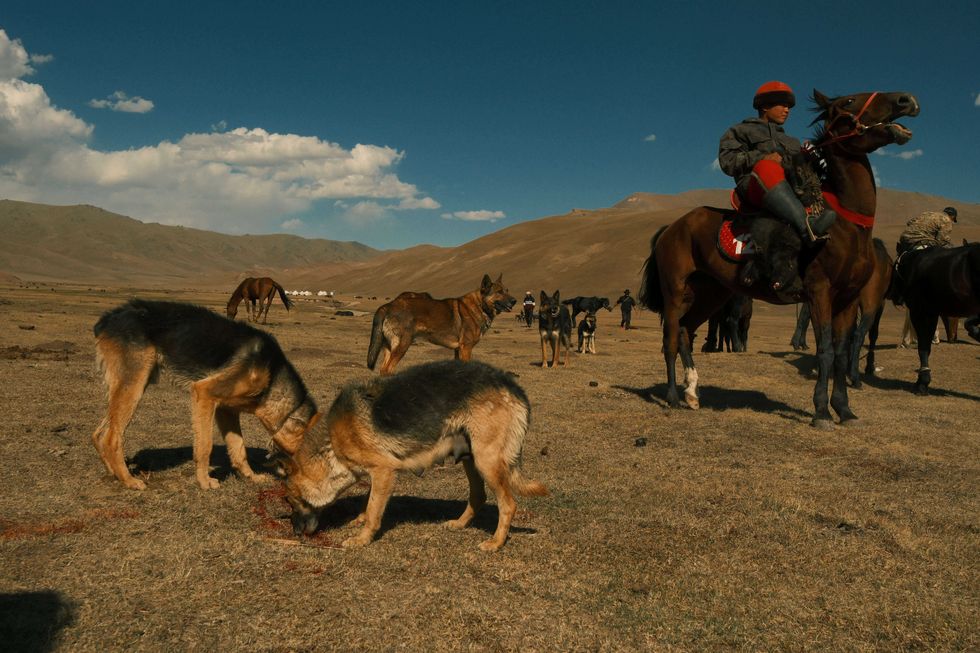
It was getting dark, and the field before us was littered with marmot holes. If my horse stepped in any of them, he would likely break a leg, and (possibly) my neck. I replied that I liked my horse very much and would hate to have to eat him if he were to be injured. After getting out of the marmot mine field, I did open into a gallop before nearly running into some other stragglers who had also run into issues. We rode on into the night. The moon had waxed just enough to give some light. We let the horses find the way, and they passed through several other stretches of treacherous ground without incident. Finally, the smoke of a yurt camp appeared in the distance. It was where we were staying the night. Riding into camp, my legs were locked up and numb from the cold. I slid off the horse and, guided by the old man whose camp we had come to, crabwalked into the dinner yurt and collapsed by a hot stove burning dried cow patties. We had ridden just under 39 miles. The next day was spent in camp.
A lamb was purchased from a local shepherd and slaughtered in ritual fashion. As the throat was slit and the blood spurted out, the nomads held out their hands and looked up to the sky in prayer. While some animal sacrifice exists in Islam, and most Kyrgyz people claim a Muslim identity, their religious beliefs also contain a great deal of Tengrism, the ancient sky-worship religion of the Central Asian steppes that predates Islam by millennia, and many of their practices (including animal sacrifice) bear more resemblance to the old religion than to contemporary Islam.
After the ritual, we were introduced to the sport of kok boru, a game dating back to Scythian times, played between two teams of horse riders competing to grab the sheep carcass and throw it into the opposing team’s goal. The carcass is placed in the center of the field, a whistle is blown, and the riders charge to the carcass. The one who picks it up must ride it to the goal while the other riders try to get him to drop it. The use of whips, horses, blows—pretty much anything is permitted to stop the rider with the carcass. Some locals showed up with a challenge. They wanted to place a large bet on the outcome, which we declined because our limited cash was reserved for emergencies. They offered to play anyway, which we accepted. About halfway through, one of their riders with the carcass blew past the goal and just kept riding.
Once we realized that he was stealing the carcass outright, a party was dispatched to ride him down, and recover the evening’s dinner. As tensions rose, the contest of choice was switched to horseback wrestling. Each man wrestled from a mounted position with the goal of dismounting his opponent, with a two-out-of-three win criteria. The Americans (we claimed the Canadians on the trip as our own) performed well and won the respect of the locals, along with a few of the kok boru goals and wrestling matches.
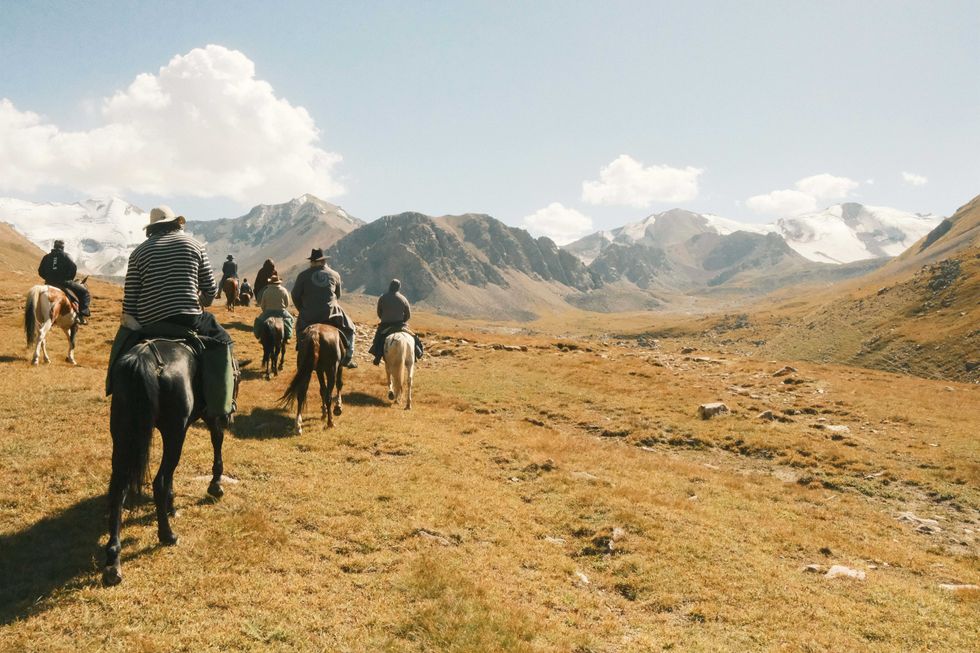
That night was one for the books, if only anyone would remember it. One of our party had gotten good news from a family emergency back home, just in time for the feast of the sacrificial lamb. The challenges we had all faced together had made us like family. The thought popped into my head of just what subversive propaganda Lord of the Flies had been. Far from turning against one another, we had pulled each other through. Another day of hard riding followed by another cold night in tents, and we reached the end of the trail.
It was a trip like no other I’ve had. Back at Le Bonne Vache, when I’d listened to my gut tell me to jump into the unknown, I was in a rut. A loss that I had tried to outrun with work, noise, and distraction still had to be confronted. The place for confrontation is the wilderness. I knew I needed to go; I was paralyzed by inaction until I wasn’t. In Kyrgyzstan, I found what I had been looking for. It was in the freedom of a land without fences. It was in the steady rhythm of the walk and the soaring flight of the gallop. It was in the intensity of the sun, the thinness of the air, and the fraternity of the group. Each long ride became a prayer—not a prayer of repetition or requests, but the simple awareness of God’s presence all around and up above.
I had gone to Kyrgyzstan chasing nomads and anthropological material for a book, but I came back with something greater: a sense of inner peace. As Kenai might say, “good heart, a little beauty—it’s enough."
Ben Braddock is an American writer. @GraduatedBen on X.
Benjamin Braddock